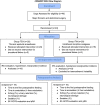Thoracic epidural anaesthesia vs intrathecal morphine in dogs undergoing major thoracic and abdominal surgery: clinical study
- PMID: 35624498
- PMCID: PMC9137148
- DOI: 10.1186/s12917-022-03296-3
Thoracic epidural anaesthesia vs intrathecal morphine in dogs undergoing major thoracic and abdominal surgery: clinical study
Abstract
Background: There is scant clinical research on neuraxial analgesia in dogs undergoing major surgery. With this study we compared the perioperative analgesic effects of thoracic epidural anaesthesia (TEA) and intrathecal morphine (ITM) in dogs scheduled for thoracic or cranial abdominal surgery. The dogs received methadone and dexmedetomidine, were anaesthetized with propofol maintained with sevoflurane, and randomly assigned to receive either TEA (ropivacaine 0.5% at 0.2 mg/kg and morphine 0.1 mg/kg administered at T12-T13) or ITM (morphine 30 μg/kg administered at L6-L7). Intraoperative rescue analgesia (iRA) was fentanyl 1 μg/kg administered if heart rate or mean arterial pressure increased by 30% above the pre-stimulation level. Glasgow Pain Composite Scale score (GPCS) dictated the use of postoperative rescue analgesia (pRA) with methadone 0.2 mg/kg.
Results: There was a statistically significant difference in iRA, median time to first fentanyl bolus, median fentanyl dose after surgical opening, and median GPCS score at 30 minutes (min), 1 ,2, 4, 6, and 8 hours (h) between the two groups (p<0.001; p<0.001; p<0.001; p<0.01; p<0.01; p<0.001; p<0.01; p=0.01; p=0.01, respectively). Fewer TEA than ITM group dogs required iRA during surgical opening and pRA: 5% (1/18) and 2/18 (11%), respectively, in the TEA and 83% (16/18) and 10/18 (55%), respectively, in the ITM group. Side effects were urinary retention in 3/18 (16%) TEA group dogs and 2/18 (11%) ITM group dogs and prolonged sedation in 2/18 (11%) in ITM group dogs. TEA and ITM were effective in managing perioperative pain in dogs undergoing thoracic or cranial abdominal surgery.
Keywords: dog; intrathecal morphine; major surgery; thoracic epidural anaesthesia.
© 2022. The Author(s).
Conflict of interest statement
The authors declare that the research was conducted in the absence of any commercial or financial relationships that could be construed as a potential conflict of interest.
Figures


References
-
- Block BM, Liu SS, Rowlingson AJ, Cowan AR, Cowan JA, Wu CL. Efficacy of Postoperative Epidural Analgesia: A Meta-analysis. J Am Med Assoc. 2003;290:2455–2463. - PubMed
-
- Pascoe PJ, Dyson DH. Analgesia After Lateral Thoracotomy in Dogs Epidural Morphine Vs. Intercostal Bupivacaine. Vet Surg. 1993;22:141–147. - PubMed
-
- Popilskis S, Kohn D, Sanchez JA, Gorman P. Epidural vs. Intramuscular Oxymorphone Analgesia after Thoracotomy in Dogs. Vet Surg. 1991;20:462–467. - PubMed
-
- Tonge M, Robson K, Alderson B. Single thoracic epidural injection for intra- and post-lateral thoracotomy analgesia in a dog. Vet Rec Case Rep. 2021;9:e183.
-
- Barretto C, Hook R, Seah CH. Use of the Tuohy needle in paramedian approach for peridural block. Anesth Analg. 1977;56:582–584. - PubMed
Publication types
MeSH terms
Substances
LinkOut - more resources
Full Text Sources
Research Materials

